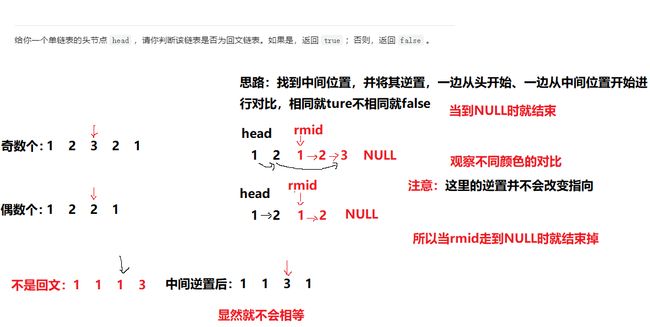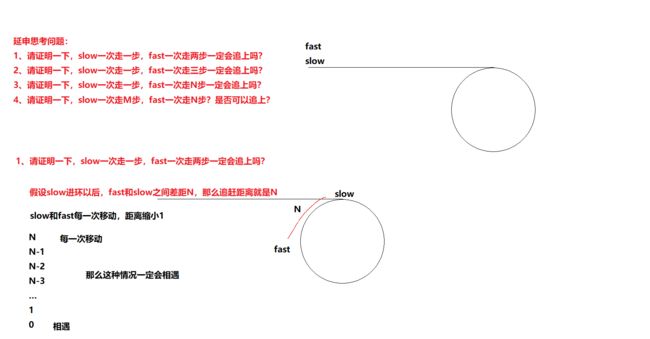leetcode链表oj题
目录
203. 移除链表元素
描述
法一描述:
法一代码
法二描述:
法二代码
优化
21. 合并两个有序链表
描述
代码
206. 反转链表
描述
思路一:
代码
思路二:
代码
876. 链表的中间结点
进阶版
链表中倒数第k个结点
描述
代码
CM11 链表分割
描述
代码
234. 回文链表
描述
代码
160. 相交链表
描述
优化
代码
141. 环形链表
描述
代码
延申问题
142. 环形链表 II
法一
代码
法二
代码
138. 复制带随机指针的链表
法一
法二
代码
结束语
203. 移除链表元素
描述
给你一个链表的头节点 head 和一个整数 val ,请你删除链表中所有满足 Node.val == val 的节点,并返回新的头节点 。
示例 1:
输入:head = [1,2,6,3,4,5,6], val = 6
输出:[1,2,3,4,5]
示例 2:输入:head = [], val = 1
输出:[ ]
示例 3:输入:head = [7,7,7,7], val = 7
输出:[ ]
提示:
列表中的节点数目在范围 [0, 104] 内
1 <= Node.val <= 50
0 <= val <= 50来源:力扣(LeetCode)
链接:https://leetcode.cn/problems/remove-linked-list-elements
法一描述:
法一代码
struct ListNode* removeElements(struct ListNode* head, int val)
{
struct ListNode* cur = head, * prve = NULL;
while (cur)
{
if (cur->val == val)
{
//两种情况头删、非头删
//1头删
if (cur == head)
{
head = head->next;
free(cur);
cur = head;
}
else//2非头删
{
prve->next = cur->next;
free(cur);
cur = prve->next;
}
}
else
{
prve = cur;
cur = cur->next;
}
}
return head;
}法二描述:
法二代码
struct ListNode* removeElements(struct ListNode* head, int val)
{
struct ListNode*cur = head;
struct ListNode*newhead = NULL, *tail = NULL;
while(cur)
{
if(cur->val != val)
{
if(tail == NULL)
{
newhead = tail = cur;
}
else
{
tail->next = cur;
tail = tail->next;
}
cur = cur->next;
}
else
{
struct ListNode* del = cur;
cur = cur->next;
free(del);
}
}
//最后节点需要置空,并且当链表为空的时候需要判断一下
if(tail)
tail->next = NULL;
return newhead;
}优化
引入哨兵头的概念
优化
/**
* Definition for singly-linked list.
* struct ListNode {
* int val;
* struct ListNode *next;
* };
*/
struct ListNode* removeElements(struct ListNode* head, int val)
{
struct ListNode* cur = head;
//不需要newhead了
//struct ListNode* newhead = NULL, *tail = NULL;
struct ListNode* guard = (struct ListNode*)malloc(sizeof(struct ListNode));
guard->next = head;
struct ListNode* tail = guard;
while(cur)
{
if(cur->val != val)
{
//引入头的概念就不需要下面的判断了
// if(tail == NULL)
// {
// newhead = tail = cur;
// }
// else
// {
// tail->next = cur;
// tail = tail->next;
// }
tail->next = cur;
tail = tail->next;
cur = cur->next;
}
else
{
struct ListNode* del = cur;
cur = cur->next;
free(del);
}
}
//最后节点需要置空,并且当链表为空的时候需要判断一下
if(tail)
tail->next = NULL;
//注意释放内存
head = guard->next;
free(guard);
return head;
}21. 合并两个有序链表
描述
将两个升序链表合并为一个新的 升序 链表并返回。新链表是通过拼接给定的两个链表的所有节点组成的
示例 1:
输入:l1 = [1,2,4], l2 = [1,3,4]
输出:[1,1,2,3,4,4]
示例 2:输入:l1 = [], l2 = []
输出:[]
示例 3:输入:l1 = [], l2 = [0]
输出:[0]
提示:
两个链表的节点数目范围是 [0, 50]
-100 <= Node.val <= 100
l1 和 l2 均按 非递减顺序 排列来源:力扣(LeetCode)
链接:https://leetcode.cn/problems/merge-two-sorted-lists
利用哨兵位可以很好的解决这个问题
代码
struct ListNode* mergeTwoLists(struct ListNode* list1, struct ListNode* list2){
struct ListNode* guard = (struct ListNode*)malloc(sizeof(struct ListNode));
//防止有链表为空,所以guard首先置为空
guard->next = NULL;
struct ListNode* tail = guard;
struct ListNode* cur1 = list1,*cur2 = list2;
while(cur1 && cur2)
{
if(cur1->val < cur2->val)
{
tail->next = cur1;
cur1 = cur1->next;
}
else
{
tail->next = cur2;
cur2 = cur2->next;
}
tail = tail->next;
}
if(cur1)
tail->next = cur1;
if(cur2)
tail->next = cur2;
struct ListNode* head = guard->next;
free(guard);
return head;
}206. 反转链表
描述
给你单链表的头节点
head,请你反转链表,并返回反转后的链表。
示例 1:
输入:head = [1,2,3,4,5]
输出:[5,4,3,2,1]
示例 2:
输入:head = [1,2]
输出:[2,1]
示例 3:输入:head = []
输出:[]
提示:
链表中节点的数目范围是 [0, 5000]
-5000 <= Node.val <= 5000
进阶:链表可以选用迭代或递归方式完成反转。你能否用两种方法解决这道题?
来源:力扣(LeetCode)
链接:https://leetcode.cn/problems/reverse-linked-list
思路一:
画图一步一步分析,会很容易理解
代码
struct ListNode* reverseList(struct ListNode* head){
struct ListNode* cur = head;
struct ListNode* newhead = NULL;
while(cur)
{
struct ListNode* next = cur->next;
cur->next = newhead;
newhead = cur;
cur = next;
}
return newhead;
}思路二:
代码
struct ListNode* reverseList(struct ListNode* head){
struct ListNode* n1,*n2,*n3;
n1 = NULL;
n2 = head;
n3 = NULL;
while(n2)
{
n3 = n2->next;
n2->next = n1;
n1 = n2;
n2 = n3;
}
return n1;
}876. 链表的中间结点
给定一个头结点为 head 的非空单链表,返回链表的中间结点。
如果有两个中间结点,则返回第二个中间结点。
示例 1:
输入:[1,2,3,4,5]
输出:此列表中的结点 3 (序列化形式:[3,4,5])
返回的结点值为 3 。 (测评系统对该结点序列化表述是 [3,4,5])。
注意,我们返回了一个 ListNode 类型的对象 ans,这样:
ans.val = 3, ans.next.val = 4, ans.next.next.val = 5, 以及 ans.next.next.next = NULL.
示例 2:输入:[1,2,3,4,5,6]
输出:此列表中的结点 4 (序列化形式:[4,5,6])
由于该列表有两个中间结点,值分别为 3 和 4,我们返回第二个结点。提示:
给定链表的结点数介于 1 和 100 之间。
来源:力扣(LeetCode)
链接:https://leetcode.cn/problems/middle-of-the-linked-list
简单的题目 -- 遍历一般链表记录个数,然后个数除以2得到中间的节点
进阶版
-- 只允许遍历一般链表
思路 -- 快慢指针
定义两个指针,fast(快) slow(慢) ,快指针一次走两步、慢指针一次走一步
当为奇数个节点时,fast走到尾,slow就走到中间节点了
当为偶数个节点时,fast走到NULL,slow就走到中间节点了
struct ListNode* middleNode(struct ListNode* head){
struct ListNode* fast , *slow;
slow = fast = head;
//当fast为空或者fast->next为空的时候结束
while(fast && fast->next)
{
slow = slow->next;
fast = fast->next->next;
}
return slow;
}链表中倒数第k个结点
这是牛客网上面的一道题目
描述
输入一个链表,输出该链表中倒数第k个结点。
示例1
输入:
1,{1,2,3,4,5}复制返回值:
{5}链表中倒数第k个结点_牛客网 -- 链接
代码
struct ListNode* FindKthToTail(struct ListNode* pListHead, int k ) {
// write code here
struct ListNode* fast , *slow;
fast = slow = pListHead;
//走K-1步,再同时走
//while(--k); //不过这样写要注意
//走K步,再同时走
while(k--)
{
if(fast == NULL) //判断空链表 -- fast指向空就停下来
{
return NULL;
}
fast = fast -> next;
}
while(fast)
{
fast = fast->next;
slow = slow->next;
}
return slow;
}CM11 链表分割
描述
现有一链表的头指针 ListNode* pHead,给一定值x,编写一段代码将所有小于x的结点排在其余结点之前,且不能改变原来的数据顺序,返回重新排列后的链表的头指针。
链表分割_牛客网 (nowcoder.com)
在牛客网上只支持C++ ,不过用C也可以写
代码
/*
struct ListNode {
int val;
struct ListNode *next;
ListNode(int x) : val(x), next(NULL) {}
};*/
class Partition {
public:
ListNode* partition(ListNode* pHead, int x) {
struct ListNode* lessGuard,*lessTail,*greaterGuard,*greaterTail;
lessGuard = lessTail = (struct ListNode*)malloc(sizeof(struct ListNode));
greaterGuard = greaterTail = (struct ListNode*)malloc(sizeof(struct ListNode));
lessGuard->next = NULL; //首先置空防止空链表的出现
greaterGuard->next = NULL;
struct ListNode* cur = pHead;
while(cur) //当cur指向空的时候停下来
{
if(cur->val < x)
{
lessTail->next = cur;
lessTail = lessTail->next;
}
else
{
greaterTail->next = cur;
greaterTail = greaterTail->next;
}
cur = cur->next; //cur向后移动
}
lessTail->next = greaterGuard->next; //把两条链表链接起来
greaterTail->next = NULL; //最后 greaterTail->next 要置空防止出现极端情况3
pHead = lessGuard->next; //重新赋值给原来的头
free(greaterGuard); //释放内存
free(lessGuard);
return pHead;
}
};234. 回文链表
描述
给你一个单链表的头节点 head ,请你判断该链表是否为回文链表。如果是,返回 true ;否则,返回 false 。
示例 1:
输入:head = [1,2,2,1]
输出:true
示例 2:
输入:head = [1,2]
输出:false
提示:
链表中节点数目在范围[1, 105] 内
0 <= Node.val <= 9
来源:力扣(LeetCode)
链接:234. 回文链表
进阶:你能否用 O(n) 时间复杂度和 O(1) 空间复杂度解决此题?
代码
class Solution {
public:
//找到中间的节点
struct ListNode* middleNode(struct ListNode* head){
struct ListNode* fast , *slow;
slow = fast = head;
//当fast为空或者fast->next为空的时候结束
while(fast && fast->next)
{
slow = slow->next;
fast = fast->next->next;
}
return slow;
}
//反转链表
struct ListNode* reverseList(struct ListNode* head){
struct ListNode* n1,*n2,*n3;
n1 = NULL;
n2 = head;
n3 = NULL;
while(n2)
{
n3 = n2->next;
n2->next = n1;
n1 = n2;
n2 = n3;
}
return n1;
}
bool isPalindrome(ListNode* head) {
//调用找到中间的节点函数
struct ListNode* mid = middleNode(head);
//调用反转链表函数
struct ListNode* rmid = reverseList(mid);
struct ListNode* cur = head;
while(rmid)
{
if(cur->val == rmid->val)
{
rmid = rmid->next;
cur = cur->next;
}
else
return false;
}
return true;
}
};第二种思路:先copy一个链表,然后再逆置copy出来的全部的链表,再和原来比较。不复制原来的链表是不行的,因为这相当于修改了链表了
160. 相交链表
描述
给你两个单链表的头节点
headA和headB,请你找出并返回两个单链表相交的起始节点。如果两个链表不存在相交节点,返回null。
160. 相交链表 -- 描述过长进去看
时间复杂度O(N^2)思路 -- 直接暴力求解
优化
代码
struct ListNode *getIntersectionNode(struct ListNode *headA, struct ListNode *headB) {
//判断是否为空链表
if(headB == NULL || headA == NULL) //测试结果leetcode并没有给定空链表的测试用例
return NULL;
//一般的情况下不改变原来的链表头 因为后面容易用到
struct ListNode* curA = headA , *curB = headB;
//找尾节点,并记录节点个数
int lenA = 1;
while(curA->next) //因为是找尾所以先设置长度为1
{
curA = curA->next;
++lenA;
}
int lenB = 1;
while(curB->next)
{
curB = curB->next;
++lenB;
}
//比较尾节点,如果是相交的话尾节点一定相同
if(curA != curB)
{
return NULL; //两个链表不相交,因此返回 null
}
//下面是建立在相交的情况下找交点的
//比较那个更长,可以先定curA较长
struct ListNode* longlist = headA , *shortlist = headB;
if(lenA < lenB)
{
longlist = headB;
shortlist = headA;
}
int gap = abs(lenA - lenB); //abs是用来求绝对值的
//让长的先走差距步
while(gap--)
{
longlist = longlist->next;
}
//再一起走
while(longlist != shortlist)
{
longlist = longlist->next;
shortlist = shortlist->next;
}
return longlist;
}141. 环形链表
描述
给你一个链表的头节点 head ,判断链表中是否有环。
如果链表中有某个节点,可以通过连续跟踪 next 指针再次到达,则链表中存在环。 为了表示给定链表中的环,评测系统内部使用整数 pos 来表示链表尾连接到链表中的位置(索引从 0 开始)。注意:pos 不作为参数进行传递 。仅仅是为了标识链表的实际情况。
如果链表中存在环 ,则返回 true 。 否则,返回 false 。
示例 1:
输入:head = [3,2,0,-4], pos = 1
输出:true
解释:链表中有一个环,其尾部连接到第二个节点。
示例 2:输入:head = [1,2], pos = 0
输出:true
解释:链表中有一个环,其尾部连接到第一个节点。
示例 3:输入:head = [1], pos = -1
输出:false
解释:链表中没有环。提示:
链表中节点的数目范围是 [0, 104]
-105 <= Node.val <= 105
pos 为 -1 或者链表中的一个 有效索引 。
进阶:你能用 O(1)(即,常量)内存解决此问题吗?
来源:力扣(LeetCode)
链接:141. 环形链表
代码
bool hasCycle(struct ListNode *head) {
//快慢指针
struct ListNode* fast , *slow;
fast = slow = head;
while(fast && fast->next) //防止空指针的访问,为空链表就不进去了
{
slow = slow->next;
fast = fast->next->next;
if(fast == slow)
return true;
}
return false;
}延申问题
142. 环形链表 II
中等
给定一个链表的头节点
head,返回链表开始入环的第一个节点。 如果链表无环,则返回null。如果链表中有某个节点,可以通过连续跟踪
next指针再次到达,则链表中存在环。 为了表示给定链表中的环,评测系统内部使用整数pos来表示链表尾连接到链表中的位置(索引从 0 开始)。如果pos是-1,则在该链表中没有环。注意:pos不作为参数进行传递,仅仅是为了标识链表的实际情况。不允许修改 链表。
示例 1:
输入:head = [3,2,0,-4], pos = 1 输出:返回索引为 1 的链表节点 解释:链表中有一个环,其尾部连接到第二个节点。示例 2:
输入:head = [1,2], pos = 0 输出:返回索引为 0 的链表节点 解释:链表中有一个环,其尾部连接到第一个节点。示例 3:
输入:head = [1], pos = -1 输出:返回 null 解释:链表中没有环。提示:
- 链表中节点的数目范围在范围
[0, 104]内-105 <= Node.val <= 105pos的值为-1或者链表中的一个有效索引
进阶:你是否可以使用
O(1)空间解决此题?142. 环形链表 II - 力扣(LeetCode)
法一
代码
/**
* Definition for singly-linked list.
* struct ListNode {
* int val;
* struct ListNode *next;
* };
*/
struct ListNode *detectCycle(struct ListNode *head) {
struct ListNode* slow = head , *fast = head;
while(fast && fast->next ) //先判断空链表的问题
{
slow = slow->next;
fast = fast->next->next;
if(fast == slow) //当相遇时停下循环,进入这一层
{
struct ListNode* ListA = head, *ListB = slow;
while(ListA != ListB) //一起走,直到找到入口点
{
ListA = ListA->next;
ListB = ListB->next;
}
return ListA;
}
}
return NULL;
}法二
代码
这个方法容易理解
/**
* Definition for singly-linked list.
* struct ListNode {
* int val;
* struct ListNode *next;
* };
*/
//这里是把 141.环形链表 稍作修改
struct ListNode * hasCycle(struct ListNode *head) {
//快慢指针
struct ListNode* fast , *slow;
fast = slow = head;
while(fast && fast->next)
{
slow = slow->next;
fast = fast->next->next;
if(fast == slow)
return fast;
}
return NULL;
}
//这里是 160.相交链表 稍作修改
struct ListNode *getIntersectionNode(struct ListNode *headA, struct ListNode *headB) {
//一般的情况下不改变原来的链表
struct ListNode* curA = headA , *curB = headB;
//找尾节点,并记录节点个数
int lenA = 1;
while(curA->next) //因为是找尾所以先设置长度为1
{
curA = curA->next;
++lenA;
}
int lenB = 1;
while(curB->next)
{
curB = curB->next;
++lenB;
}
//比较那个更长,可以先定curA较长
struct ListNode* longlist = headA , *shortlist = headB;
if(lenA < lenB)
{
longlist = headB;
shortlist = headA;
}
int gap = abs(lenA - lenB); //abs是用来求绝对值的
//让长的先走差距步
while(gap--)
{
longlist = longlist->next;
}
//再一起走
while(longlist != shortlist)
{
longlist = longlist->next;
shortlist = shortlist->next;
}
return longlist;
}
struct ListNode *detectCycle(struct ListNode *head) {
//找到相遇节点
struct ListNode * meet = hasCycle(head);
//如果为空就直接返回NULL
if(meet == NULL)
return NULL;
//新链表B
struct ListNode * ListB = meet->next;
//把原来的置空 -- 防止找到B
meet->next = NULL;
//新链表A
struct ListNode * ListA = head;
//返回并保存目标节点
struct ListNode *entryNode = getIntersectionNode(ListA,ListB);
meet->next = ListB;//恢复成原链表 -- 为了不破坏原链表
return entryNode;
}138. 复制带随机指针的链表
中等
138. 复制带随机指针的链表 - 力扣(LeetCode) -- 进去看看呗
法一
提供思路:1、遍历原链表,复制节点 -- 一个一个尾插
2、更新random,找random原链表中第i个
对应新链表中第i个 -- 即一一对应,因为可能节点中的值一样,
靠值找random是不靠谱的
时间复杂度:O(N^2)
法二
时间复杂度:O(N)
代码
/**
* Definition for a Node.
* struct Node {
* int val;
* struct Node *next;
* struct Node *random;
* };
*/
struct Node* copyRandomList(struct Node* head) {
//1.插入copy节点
//保存头节点指针,防止头被改动,找不到头
struct Node* cur = head;
//先创立指针,方便使用
struct Node* copy = NULL;
struct Node* next = NULL;
while(cur) //当为空的时候停下来
{
//链接
//保存cur的下一个节点,为链接准备
next = cur->next;
copy = (struct Node*)malloc(sizeof(struct Node));
//拷贝数据
copy->val = cur->val;
cur->next = copy;
copy->next = next;
//迭代向后走
cur = next;
}
//2.更新copy->random
//重新指向头
cur = head;
while(cur)
{
//更新copy
copy = cur->next;
if(cur->random == NULL)
copy->random = NULL;
else
copy->random = cur->random->next;
//迭代,向后走
cur = cur->next->next;
}
//3.把copy节点解下来链接一起,并恢复原链表
//创立两个方便尾插
struct Node* copyHead = NULL, * copyTail = NULL;
//重新指向
cur = head;
while(cur) //cur为空停下来
{
//更新copy并保留cur->next->next,尾恢复原链表准备
copy = cur->next;
next = copy->next;
//取节点尾插
//判断为空的时候 -- 尾插
if(copyTail == NULL)
{
copyHead = copyTail = copy;
}
//尾插
else
{
copyTail->next = copy;
copyTail = copyTail->next;
}
//恢复原链表
cur->next = next;
//迭代
cur = copy->next;
}
return copyHead;
}结束语
读书不觉春已深,一寸光阴一寸金。
唐·王贞白 《白鹿洞二首·其一》





























